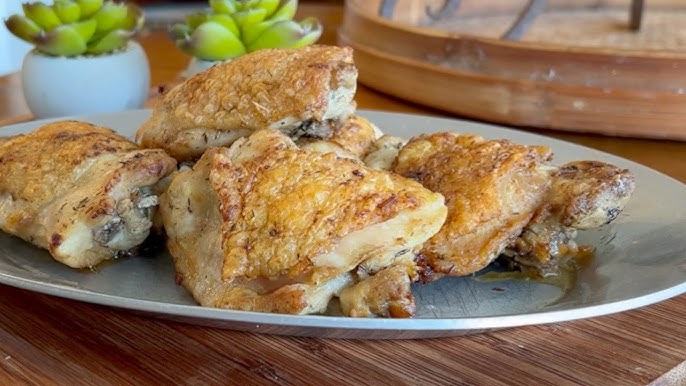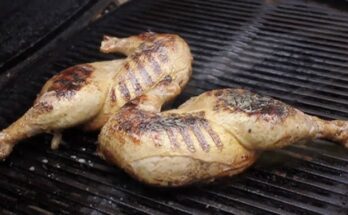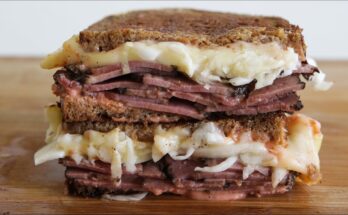Cornell Chicken Recipe: If you’ve ever been to upstate New York, chances are you’ve heard about Cornell Chicken—a legendary recipe that has stood the test of time. This isn’t your average grilled chicken; it’s a dish that carries both history and flavor in every bite. The recipe was developed in the 1940s by Dr. Robert C. Baker, a food scientist at Cornell University, who is often nicknamed the “Edison of Poultry.” He created this marinade to keep chicken juicy, flavorful, and irresistible, especially when grilled outdoors.
What makes Cornell Chicken so unique is its egg-based marinade, which works almost like a magical potion for poultry. The egg acts as an emulsifier, binding together the oil, vinegar, and spices, so the chicken absorbs the flavors deeply and stays moist even after cooking over high heat. Unlike many other barbecue recipes, this marinade creates a balance of tangy, savory, and smoky flavors without overwhelming the natural taste of the chicken.
Beyond its incredible flavor, Cornell Chicken is a cultural staple in New York state fairs, community cookouts, and backyard gatherings. Families have passed it down through generations, making it more than just a meal—it’s a tradition. Think of it as upstate New York’s answer to southern fried chicken or Texas brisket. If you want to experience a bite of authentic American culinary history, then learning how to make Cornell Chicken at home is a must.
Ingredients You’ll Need
Getting Cornell Chicken right depends heavily on the marinade. It’s simple, but each ingredient plays an important role. Below is a detailed breakdown of what you’ll need:
Main Ingredients for Marinade
- 2 large eggs (the key binding ingredient)
- 1 cup vegetable oil (helps keep the chicken moist)
- 2 cups cider vinegar (adds tang and tenderizes the meat)
- 3 tablespoons salt (flavor enhancer and preservative)
- 1 tablespoon poultry seasoning (classic savory touch)
Additional Spices & Flavor Boosters
- 1 teaspoon black pepper (mild spice and aroma)
- 1 teaspoon garlic powder (deepens flavor profile)
- 1 teaspoon onion powder (adds richness)
- 1 teaspoon paprika (subtle smokiness and color)
- 1 tablespoon sugar or honey (optional, balances acidity)
Best Type of Chicken to Use
Traditionally, this recipe calls for a whole chicken cut in half or chicken quarters (legs and thighs). These cuts are perfect because they hold up well during grilling and absorb the marinade deeply. However, you can also use bone-in chicken breasts if you prefer white meat. For a faster option, boneless thighs work too, though they may not capture the same smoky charm as bone-in cuts.
The key here is to use skin-on chicken—the skin crisps beautifully over the grill, while locking in the juices. Without the skin, you may lose some of that signature Cornell Chicken texture and taste.
Step-by-Step Guide to Making Cornell Chicken
Now that you have your ingredients ready, it’s time to bring this iconic recipe to life. Follow this detailed process to achieve that authentic upstate New York flavor at home.
Preparing the Marinade
Start by cracking two large eggs into a mixing bowl and whisking them until smooth. Slowly drizzle in the vegetable oil while whisking continuously—this helps emulsify the mixture, creating a creamy base. Next, add the cider vinegar, salt, and poultry seasoning. Stir until everything is well-blended, then mix in your additional spices (pepper, garlic powder, onion powder, paprika).
The result should be a tangy, slightly thick marinade that clings to the chicken instead of running off. If you prefer a hint of sweetness, add sugar or honey at this stage.
Marinating the Chicken
Place your chicken pieces into a large resealable bag or shallow dish. Pour the marinade generously over them, making sure each piece is well coated. For best results, let the chicken marinate in the refrigerator for at least 4 hours, but ideally overnight. This allows the vinegar to tenderize the meat while the egg and oil lock in moisture.
Don’t rush this step—Cornell Chicken is all about patience and flavor absorption.
Grilling vs. Oven-Baking Cornell Chicken
Traditionally, Cornell Chicken is grilled over charcoal, which gives it a smoky flavor and slightly crispy exterior. Place the chicken skin-side down first, then flip occasionally while basting with extra marinade. Cooking time depends on the cut, but generally, it takes 40–50 minutes until the internal temperature reaches 165°F (74°C).
If you don’t have a grill, you can oven-bake the chicken at 375°F (190°C) for about 45–55 minutes, basting every 15 minutes. While the oven method won’t provide the same smoky taste, it still results in juicy, flavorful chicken.
Achieving the Perfect Crisp & Juiciness
The secret lies in basting frequently. Unlike many recipes where basting is optional, Cornell Chicken demands it. The marinade not only adds flavor but also helps create that beautiful golden-brown crust on the outside. Keep an eye on the chicken to avoid burning, especially if you’re using a charcoal grill.
By the time it’s done, your kitchen or backyard will be filled with a mouthwatering aroma, and you’ll be left with chicken that’s crispy on the outside yet tender and juicy inside—a perfect balance.
Serving Suggestions
So, you’ve grilled up some juicy, golden-brown Cornell Chicken—now what? The beauty of this recipe is that it pairs wonderfully with a wide variety of side dishes. Because the marinade is tangy, savory, and just slightly smoky, you’ll want accompaniments that balance or complement those flavors.
Classic Side Dishes for Cornell Chicken
Nothing screams “summer barbecue” like pairing Cornell Chicken with old-fashioned picnic sides. Here are a few traditional favorites:
- Potato Salad – Creamy potato salad with mayonnaise, mustard, and celery is a timeless choice. The cool creaminess balances the tang of the chicken.
- Corn on the Cob – Grilled or boiled corn slathered with butter and a sprinkle of salt is the perfect sidekick.
- Coleslaw – Crisp and refreshing, coleslaw adds crunch and helps cut through the richness of the marinade.
- Macaroni Salad – This upstate New York staple often appears alongside Cornell Chicken at fairs and cookouts.
- Baked Beans – Slightly sweet and smoky baked beans create a comforting, hearty side.
Beverage Pairings
Food tastes even better when paired with the right drink. Try these options:
- Iced Tea or Lemonade – Refreshing and slightly sweet, perfect for hot summer days.
- Light Beer or Lager – A crisp, cold beer pairs well with the smoky, tangy chicken.
- Dry White Wine – Sauvignon Blanc or Chardonnay balances the vinegar notes.
The goal here is simple: keep it light, refreshing, and summery. Cornell Chicken shines brightest when surrounded by flavors that don’t overpower it.
Tips & Tricks for Perfect Cornell Chicken
Even though the recipe is straightforward, a few expert tips can make the difference between good chicken and unforgettable chicken.
Common Mistakes to Avoid
- Not Marinating Long Enough – A quick dip won’t cut it. Cornell Chicken needs several hours, ideally overnight, for maximum flavor.
- Skipping the Baste – Many home cooks forget to baste often. Without it, you lose the signature crust and depth of flavor.
- Cooking on High Heat – Too much direct heat burns the skin before the inside cooks. Use medium heat for slow, even cooking.
- Using Skinless Chicken – The skin locks in moisture and crispiness. Without it, you lose that classic texture.
Expert Hacks for Extra Flavor
- Add Wood Chips – If grilling, throw in some applewood or hickory chips for extra smokiness.
- Brush with Butter Before Serving – A quick brush of melted butter right before serving enhances flavor and adds shine.
- Marinate in a Large Ziploc Bag – This ensures all sides of the chicken are evenly coated and easy to flip.
- Reserve Some Marinade for Basting – Always keep a separate portion of marinade for basting so you’re not reusing raw chicken juice.
Following these tricks can elevate your Cornell Chicken from “great” to “absolutely unforgettable.”
Nutritional Value of Cornell Chicken
While Cornell Chicken is rich in flavor, you may be wondering about its nutritional profile. The good news? It’s not nearly as heavy as many fried or breaded chicken dishes.
Calories and Protein Breakdown
On average, a grilled chicken quarter prepared with the Cornell marinade contains:
- Calories: 300–350
- Protein: 25–30 grams
- Fat: 15–20 grams (mostly from the oil in the marinade and chicken skin)
- Carbohydrates: 2–4 grams (minimal, since the marinade isn’t sugar-heavy)
Because it’s grilled, much of the fat drips away, making it lighter than fried alternatives.
Healthier Alternatives
If you want to lighten up the dish without sacrificing too much flavor:
- Use skinless chicken breasts instead of thighs.
- Swap vegetable oil for olive oil in the marinade.
- Reduce salt slightly if you’re watching sodium intake.
- Use Greek yogurt as a partial substitute for oil—it keeps the chicken moist with less fat.
Cornell Chicken is surprisingly versatile. Whether you’re indulging at a summer barbecue or tweaking it for a healthier meal prep, it remains flavorful and satisfying.
Variations of Cornell Chicken
Although the classic recipe is unbeatable, it’s always fun to add your own twist. Here are a couple of creative spins:
Spicy Cornell Chicken
If you love a little heat, simply add:
- 1 teaspoon cayenne pepper
- 1 tablespoon hot sauce (Frank’s RedHot works beautifully)
- ½ teaspoon crushed red pepper flakes
This version has the same tangy base but with a fiery kick. Perfect for spice lovers!
Herb-Infused Cornell Chicken
Want something more fragrant and aromatic? Try adding:
- Fresh rosemary, thyme, or oregano to the marinade
- Lemon zest for a citrusy brightness
- A touch of Dijon mustard for extra depth
This variation leans more toward Mediterranean flavors while keeping the Cornell tradition alive.
Why Try This Recipe at Home?
If you’re still on the fence about making Cornell Chicken, let me give you a few convincing reasons why it’s worth firing up your grill or preheating your oven. This dish isn’t just another chicken recipe—it’s a piece of American culinary history and a guaranteed crowd-pleaser.
Cost-Effective and Delicious
One of the biggest advantages of Cornell Chicken is that it uses simple, affordable ingredients. Eggs, vinegar, oil, and basic spices are pantry staples most of us already have on hand. Compared to marinades that require expensive sauces or specialty herbs, this one is budget-friendly while delivering maximum flavor.
Also, because the recipe works well with whole chickens or quarters, you can feed a family or a group of friends without breaking the bank. A backyard cookout with Cornell Chicken can easily serve many guests at a fraction of the cost of takeout or catering.
Family-Friendly Meal
Cornell Chicken is mild enough for kids but flavorful enough to impress adults. Unlike overly spicy or overly sweet marinades, it strikes the perfect balance that everyone at the table can enjoy. Plus, it’s versatile—you can serve it hot off the grill for dinner, cold in sandwiches the next day, or even shredded into salads.
Cooking this recipe at home also creates an experience. The act of marinating, grilling, basting, and serving is a fun ritual that brings families together. Imagine a summer evening in the backyard: kids running around, adults gathered near the grill, and the smell of sizzling Cornell Chicken filling the air. It’s not just food—it’s a memory in the making.
Storage and Reheating Tips
Like most grilled chicken recipes, Cornell Chicken tastes best fresh off the grill, but that doesn’t mean the leftovers should go to waste. In fact, this chicken reheats beautifully if you follow the right methods.
How to Store Leftovers
- Allow the chicken to cool to room temperature before storing.
- Place in an airtight container or wrap tightly in foil.
- Refrigerate for up to 4 days.
- For longer storage, freeze portions in freezer-safe bags for up to 2 months.
Best Reheating Methods
- Oven Method (Best for Maintaining Crispness):
Preheat your oven to 350°F (175°C). Place chicken on a baking sheet, cover with foil to retain moisture, and heat for about 15–20 minutes. Remove the foil for the last few minutes to crisp the skin. - Stovetop Method (Quick Fix):
Place chicken pieces in a skillet with a splash of water or chicken broth. Cover with a lid and heat over medium until warmed through. - Microwave Method (Fastest but Least Ideal):
If you’re short on time, microwave on medium power in short bursts. Cover with a damp paper towel to prevent drying out.
Leftover Cornell Chicken can also be repurposed into wraps, sandwiches, or salads. Its tangy flavor holds up well even when cold, making it a perfect meal-prep option.
FAQs about Cornell Chicken Recipe
1. Can I make Cornell Chicken without a grill?
Yes! While grilling gives the best smoky flavor, you can bake it in the oven at 375°F (190°C) for about 45–55 minutes, basting every 15 minutes.
2. How long should I marinate the chicken?
For best results, marinate for at least 4 hours, but overnight is ideal. This ensures the flavors penetrate deeply and the chicken stays juicy.
3. Can I use boneless chicken for this recipe?
Absolutely. Boneless thighs or breasts work fine, though bone-in cuts with skin deliver the most authentic flavor and texture.
4. What sides go best with Cornell Chicken?
Classic barbecue sides like potato salad, coleslaw, corn on the cob, and baked beans pair perfectly with this tangy, savory chicken.
5. Can I prepare Cornell Chicken ahead of time?
Yes. You can marinate the chicken up to 24 hours in advance and store it in the fridge. You can also grill it ahead and reheat it for serving.
Conclusion
What makes it truly special is its simplicity. With basic ingredients and straightforward steps, anyone can master it. Add in a little patience for marinating and a watchful eye while grilling, and you’ll be rewarded with golden-brown chicken that’s crispy on the outside, juicy on the inside, and bursting with flavor.
So, the next time you’re planning a barbecue or just want to try something new in your kitchen, give Cornell Chicken a shot. Once you taste it, you’ll understand why this recipe remains a beloved staple in upstate New York—and why it deserves a spot in your recipe collection too.



